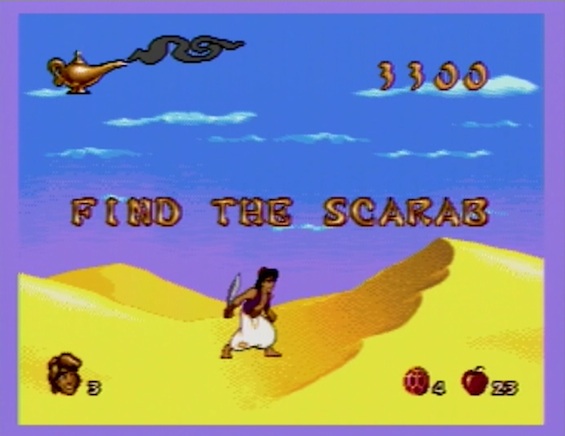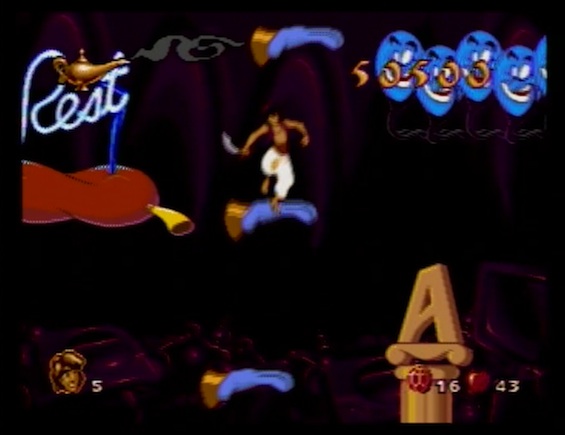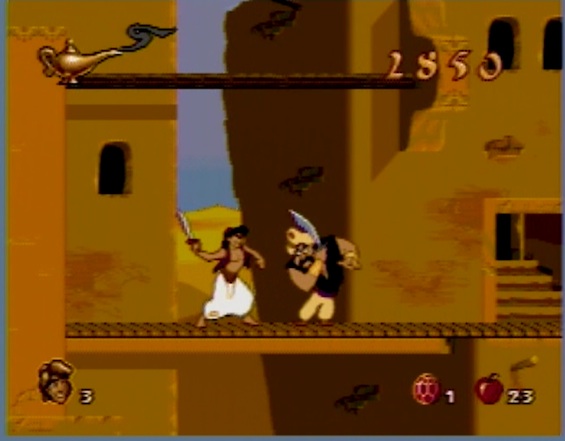Throughout the history of videogames, various consoles have served as one of the many pulpits for the gospel of film marketing. Videogame adaptations of movies are a strange breed. Motion Pixels will examine one such game each week, dissecting the basic gameplay, the graphics, and how faithfully it adapts the film on which it is based. Some are good, some are awful, and some are just down right weird, but they are all interesting experiments. We will also take a look at other cogs in a given film’s marketing machine. Grab some popcorn and a joystick and let the games begin!

Game/Movie: Aladdin
System: Sega Genesis
Developer: Virgin Interactive
Year of Release: 1993
Graphics and Mechanics
The Aladdin Genesis game is exceptionally well designed. Being a 16-bit system, the Sega Genesis boasts environments that are fully encompassing with artifacts in the foreground of the gamer’s view as well as those that would typically scroll past as the gamer moved from one side of the screen to the other. The progression of the levels are often unsatisfied with a simple straight line from the left of the screen to the right. There are levels that demand of you to find or destroy objects in order to proceed. Fortunately, there are helpful, and in-no-small-fashion welcome, instructions brandished across the screen to reveal these level-specific tasks. I also enjoyed the fact that there are levels that have you traversing the screen from right to left; this, of course, being counter to the typical orientation of a side-scroller.
The character design in the Aladdin game is crisp and fully realized to the point that they resemble animate paper dolls. Some may view this as a negative, but I find that it seamlessly integrates into the game. The characters’ facial features are all visible and their physical movements so well animated that it more closely resembles the drawings used to great effect in the film. It may give the game a “cartoony” or even juvenile aesthetic, but isn’t that apropos considering the material it’s adapting? I love the differing heights, weights, and musculatures on the various palace guards; some are giant brutes while others are squat, face-stuffing toads. Even the non-human enemies are well constructed and feel as if they could exist in Disney’s vision of Aladdin. The camel that spits whenever you jump on his back is especially choice; his loogies being lethal to your foes.
The Sega Genesis controller features a selection of three buttons as well as the requisite directional pad. Unlike that of its 16-bit cousin the SNES, the controller layout of the Sega Genesis did not last. While the SNES controller format evolved and served as the model for that of current gaming systems, the Genesis’ controller setup suffered the same extinction as the dodo bird, the passenger pigeon, and the mini-disc player. Aladdin of course has the ability to jump and climb, but the game also offers two different types of attacks. A sharp scimitar constitutes his melee weapon while a bushel of throwing apples provides for a more ranged attack. This makes the enemies in the game more manageable and adds to the already staggering replay value by giving the player an arsenal from which to strategically draw. Often defeating the bosses of various levels depends on discovering which of these two attacks is more effective. I love that there exists an interaction between the environments and the ranged attack; Aladdin’s apples sliced in half by the errant blades of the knife jugglers.
Though admittedly it is probably a byproduct of my favoring the Sega to the SNES as a sprat, but I find that setup to be more ergonomically sound. The thumb moving in a straight line across the three buttons demands less of your dexterity and therefore incrementally increases finger speed. The game also allows the player the opportunity to choose different button designations; allowing for individual optimization of gameplay.
The one problem I do have, and this is seriously nitpicky considering just how fantastic a game Aladdin really is, has to do with a recurring issue in 16-bit games. I believe I mentioned this when covering The Mask on SNES, but the foreground artifacts can sometimes be a hindrance. In the Aladdin game, the sultan’s dungeon characterizes the biggest setback. There is an element of the level that necessitates leaping onto appearing and then vanishing stones to make your way up to the exit. The pillars and chains in the foreground, while augmenting the overall dungeon atmosphere, can make spotting these stones quite the irritating task.

It’s a question of style over function, but the issue is fleeting while the enhancement to the visual landscape of the game is extraordinary.
Playing Before Instructions
Aladdin on Sega Genesis represents one of the benchmarks of my videogame adolescence. My brother and I didn’t have a massive assortment of games for this system, but those we did own enjoyed no small amount of attention. We would go months wherein this game would get played every single day. Suffice it to say, Aladdin was one of our all time favorite titles. Though it had been many years since I last played the game, it quickly became apparent that the imprint of the game upon my brain had not waned over time. Strategies for taking out bosses, the locations of secret passages and hidden bonuses, and vital obstacle patterns all came flooding back as if no time had passed since my last enco-=unter with the game. Granted, the game is very self-explanatory and I would wager even if this were the first time you’d saddled up to it, you would be beholden to no Internet walkthrough in order to reach the end.
Mission Accomplished?
Indeed. As I mentioned, I played the game so often as a kid that working my way through it now was almost second nature so it isn’t really an impressive feat. Additionally, Aladdin on Sega Genesis is a game catering toward a younger and more novice audience. Sure, it’s a game based on a Disney film so that automatically insinuates a younger demographic, but it’s the gameplay itself that facilitates the unseasoned player. Throughout the game, Aladdin collects jewels that can be utilized to not only purchase additional lives but additional continues as well. The player can also obtain icons shaped like the genie’s head that offer more tries in the slot-style bonus round...

...which can then lead to even more lives. On top of all of this, there is no shortage of save points throughout almost every level which, when used in conjunction with the extra continues and lives, allows for even the most brazen, bullheaded, and clumsy gamer (which adequately describes my gaming tendencies at times) to blindly progress through the game with ease. Outside a lengthy stagnation during the escape from the cave of wonders (the bane of younger Brian’s existence once upon a time), beating the game again was relatively stress-free.
Faithful to its Source?
Tremendously so. The game follows the plot of the film nearly to the letter. It begins in Agrabah with Aladdin trying to stay one-step ahead of the palace guards. Aladdin must then collect the halves of the golden scarab to reveal the way to the cave of wonders. I found it funny however that the player is tasked with finding three “halves” of the scarab.

At least they are faithful to the film…if not elementary school math books. Aladdin must then escape from the palace dungeon, explore the cave of wonders, and then flee the cave as Abu’s insolence causes the walls to fall down around him. He then makes his way through the palace itself; first as it appears at the beginning of the film and then again under the odious influence of Jafar. The final battle is a two-fold showdown between Jafar the evil wizard and then Jafar the giant cobra; identical to the film’s climax.

The only level not based on an actual film locale takes place inside the lamp.

But even then, the images and elements of that level are firmly rooted in various incarnations of the genie throughout the film. It’s interesting because you can easily subscribe to the notion that this is indeed what transpires inside the genie’s head at any given moment. Frankly, I’m not convinced this isn’t what takes place in the coke-addled brain of Robin Williams as well; God love the hairy bastard. In any event, it amounts to one of the most entertaining and whimsically satisfying levels in the entire game.
The movie needed very little tweaking to adequately lend itself to videogame adaptation. All it required was to adopt a more combative relationship between Aladdin and his various cinematic foes and the rest evolved naturally from the film’s desert setting and Arabian Nights mythology. Instead of playfully, comically pants-ing a palace guard or having Abu pull their hats down over their heads, Aladdin instead dispatches them with a swing of his sword. The intensity of his sword swings...

...as well as those of the most sinister of the recurring guards in the game, kind of cast a darker tone over their rivalry. I love that even the most auxiliary character or set piece from the film is offered various and unique spotlights as obstacles for our hero. The statue bearing the jewel that triggers the collapse of the cave of wonders becomes a vital key to successfully completing that level. Many of the game’s more recognizable characters serve as end-of-level or midlevel bosses; Iago and Gazeem being the most notable.
How can you possibly discuss a Disney film-to-game adaptation without talking about the game’s incorporation of the film’s music? Aladdin does a superb job of integrating Alan Menkin’s remarkable, Oscar-winning score and gives it the perfect 16-bit treatment. The game opens with a moving instrumental version of “A Whole New World” and the first level is underscored by a Sega-tastic rendition of “Prince Ali.” Many of the film’s other signature songs turn up throughout the game, but even the music unrelated to the film feels very much at home within the Aladdin universe.
Final Thoughts
I grazed the subject earlier, but Aladdin on Sega Genesis has an absurd replay value. I’m sure it would be easy to write it off as being too infantile to offer any amusement to the serious gamer. But something about the game’s commitment to quality design, flawless execution, and fantasy-laden charm make it irresistibly fun. It could very well be a lingering remnant of my youth, but something about being given the opportunity to ride Aladdin’s magic carpet through the crumbling cave of wonders as a tidal wave of flame chases after you is phenomenal.

I’m interested to see how the SNES version of this game differs from the Sega Genesis version. As I understand it, and from the limited research I’ve conducted, the SNES Aladdin game is not simply a port of the Genesis edition. Maybe someday, when the wind’s from the east and the sun’s from the west and the sand in the glass is right, I’ll cover those releases for Motion Pixels. I think that might be around seven months from now, I don’t know the conversion rate.
Licensed to Sell
If there is one company that understands the finer points of squeezing every last nickel out of any given property, it’s Disney. The sheer volume of toys, apparel, toiletry items, food products, makeup kits, wart removal creams, gardening equipment, and home pregnancy tests licensed by Disney is mind-boggling. Ok, I may have made up some of those, but my point remains intact. I am ashamed to say that, as a kid, I attended a few of the shameful spectacles of mass consumerism that fell under the banner of Disney on Ice. It was a vain attempt by one of the world’s largest corporations to instill in small children a deep love for figure skating. Sure, we went to these shows, but the performers might as well have been windsurfing or gliding around a well-mopped kitchen floor in their socks for all it was worth. All that registered with us were the cheap toys hocked at these events and the mountains of cotton candy we were inexplicably allowed to consume.
